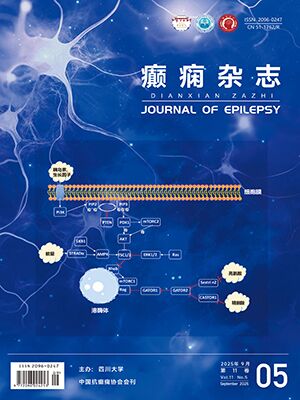| 1. |
Kwan P, Arzimanoglou A, Berg A, et al. Definition of drug resistant epilepsy: consensus proposal by the Ad Hoc Task Force of the ILAE Commission on Therapeutic Strategies. Akt Neurol, 2010, 37(8): 1069-1077.
|
| 2. |
Janson Marnie T, Bainbridge Jacquelyn L, et al. Continuing burden of refractory epilepsy. The Annals of pharmacotherapy, 2021, 55(3): 406-408.
|
| 3. |
Yoo JY, Panov F. Identification and treatment of drug-resistant epilepsy. CONTINUUM: Lifelong Learning in Neurology, 2019, 25(2): 362-380.
|
| 4. |
張英菊, 侯麗亞, 馮麗榮, 等. 難治性癲癇的抗癲癇藥物耐藥性機制研究進展. 神經疾病與精神衛生, 2019, 19(6): 631-635.
|
| 5. |
L?scher W. Animal models of intractable epilepsy. Progress in Neurobiology, 1997, 53(2): 239-258.
|
| 6. |
Vizuete Adriana Fernanda K, Mittmann HM, Alberto GC, et al. Phase-dependent astroglial alterations in li-pilocarpine-induced status epilepticus in young rats. Neurochemical research, 2017, 42(10): 2730-2742.
|
| 7. |
Marques-Carneiro J E, Persike D S, Litzahn J J, et al. Hippocampal proteome of rats subjected to the li-pilocarpine epilepsy model and the effect of carisbamate treatment. Pharmaceuticals, 2017, 10(3): 67.
|
| 8. |
龍莉莉, 肖波, 李國良, 等. 氯化鋰-匹羅卡品致大鼠的模型研究. 神經損傷與功能重建, 2010, 5(02): 83-88.
|
| 9. |
Ji-Eun K, Kyung-Ok C. The pilocarpine model of temporal lobe epilepsy and EEG monitoring using radiotelemetry system in mice. Journal of visualized experiments: JoVE, 2018, (132): 56831.
|
| 10. |
王麗琨, 周鑫, 伍國鋒, 等. 建立杏仁核電刺激慢點燃和匹羅卡品化學點燃耐藥性顳葉癲癇模型并對比癲癇發作和海馬超微結構的變化. 中風與神經疾病雜志, 2019, 36(2): 112-115.
|
| 11. |
陳姝璇, 王麗琨, 伍國鋒. 杏仁核電點燃癲(癇)模型與氯化鋰-匹羅卡品大鼠癲(癇)模型的對比研究. 癲癎與神經電生理學雜志, 2016, 25(3): 129-132.
|
| 12. |
顧友余, 陳文杰, 秦炯. 癲癇研究中常用的體外模型及嚙齒類動物模型. 生理科學進展, 2019, 50(05): 375-380.
|
| 13. |
Lévesque M, Avoli M. The kainic acid model of temporal lobe epilepsy. Neuroscience and Biobehavioral Reviews, 2013, 37(10): 2887-99.
|
| 14. |
朱飛, 郎森陽, 王群. 顳葉癲癇動物模型. 中國抗癲癇協會. 第六屆 CAAE 國際癲癇論壇摘要集. 中國抗癲癇協會: 中國抗癲癇協會, 2015: 90-91.
|
| 15. |
王軍, 李承宗, 龍浩, 等. 顳葉癲癇動物模型研究進展. 中國神經精神疾病雜志, 2019, 45(1): 60-64.
|
| 16. |
Giorgia C, Alberto P, Mariana A, et al. High concordance between hippocampal transcriptome of the mouse intra-amygdala kainic acid model and human temporal lobe epilepsy. Epilepsia, 2020, 61(12): 2795-2810.
|
| 17. |
王玉嬌, 陳燁, 師忠芳, 等. 大鼠海人酸點燃海馬與杏仁核顳葉癲癇模型發作特點及海馬病理學改變的研究. 中華神經外科雜志, 2019, (3): 305-311.
|
| 18. |
Zachary Z, Mikaela B, Caara L, et al. Targeting the mouse ventral hippocampus in the intrahippocampal kainic acid model of temporal lobe epilepsy. eNeuro, 2018, 5(4): 0158-18.
|
| 19. |
Sehirli Umit S, Ozlem K, Kutluhan T, et al. Differences in neurodegeneration between kainic acid-injected GAERS and wistar rats. Turkish neurosurgery, 2019, 29(4): 478-485.
|
| 20. |
周鑫, 陳中瑋, 王麗琨, 等. 大鼠杏仁核快速電刺激點燃癲癇模型的建立. 中華醫學會神經病學分會第十次全國腦電圖與癲癇診治進展高級講授班及學術研討會, 2015: 1.
|
| 21. |
馬新財, 孫蒙蒙, 呼奶英, 等. 大鼠海馬和杏仁核電點燃癲癇模型的比較. 山西醫科大學學報, 2017, 48(10): 986-991.
|
| 22. |
Yuanxin H, Lin W, Siying R, et al. The Expression of ZnT3 and GFAP is potentiated in the hippocampus of drug-resistant epileptic rats induced by amygdala kindling. Neuroimmunomodulation, 2020, 27(2): 104-112.
|
| 23. |
Nirwan N, Vyas P, Vohora D. Animal models of status epilepticus and temporal lobe epilepsy: a narrative review. Reviews in the Neurosciences, 2018, 29(7): 757-770.
|
| 24. |
高青, 曾貴榮, 歐陽冬生. 6 Hz 角膜點燃癲癇動物模型的研究進展. 中國實驗動物學報, 2019, 27(03): 393-398.
|
| 25. |
Zhu L, Rekha J, Evelyne G, et al. Deletion of semaphorin 3F in interneurons is associated with decreased GABAergic neurons, autism-like behavior, and increased oxidative stress cascades. Molecular neurobiology, 2019, 56(8): 5520-5538.
|
| 26. |
Wolfgang L, Heidrun P, M S S, et al. Drug resistance in epilepsy: clinical impact, potential mechanisms, and new innovative treatment options. Pharmacological reviews, 2020, 72(3): 606-638.
|
| 27. |
Patel DC, Tewari BP, Chaunsali L, et al. Neuron–glia interactions in the pathophysiology of epilepsy. Nature Reviews Neuroscience, 2019, 20(5): 282-297.
|
| 28. |
Steinh?user C, Grunnet M, Carmignoto G. Crucial role of astrocytes in temporal lobe epilepsy. Neuroscience, 2016, 323: 157-69.
|
| 29. |
Clark I A, Vissel B. Excess cerebral TNF causing glutamate excitotoxicity rationalizes treatment of neurodegenerative diseases and neurogenic pain by anti-TNF agents. Journal of Neuroinflammation, 2016, 13(1): 236.
|
| 30. |
李巷, 潘建青, 康慧聰, 等. p-JNK/p-c-Jun 通路參與大鼠杏仁核點燃癲癇模型. 神經損傷與功能重建, 2016, 11(6): 473-475.
|
| 31. |
Carme A, de Lemos Luisa, Ester V, et al. Role of JNK isoforms in the kainic acid experimental model of epilepsy and neurodegeneration. Frontiers in bioscience (Landmark edition), 2017, 22: 795-814.
|
| 32. |
Feng Z X, Yuan L, Maraj A M, et al. Microglial mTOR is neuronal protective and anti-epileptogenic in the pilocarpine model of temporal lobe epilepsy. The Journal of neuroscience: the official journal of the Society for Neuroscience, 2020, 40(40): 7593-7608.
|




